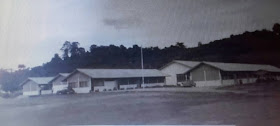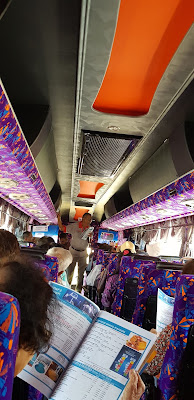Melaka: Itinerant vendors of my childhood days
By Wan Chwee Seng
The long, lonesome crow of a rooster that lingered in the early morning air was drowned by the drawn-out calls of tofuuuu…. as a bean curd vendor pedalled his way along a hard-beaten dirt track leading to a village. The village of Batu Berendam where our family stayed in the mid 1950s was located about eight kilometres from Melaka Town. With inadequate transportation and only two small grocer shops to provide the villagers with their household needs and other necessities, the villagers had to rely on the itinerant vendors to purchase household items that were not available in the provision shops. Like the tofu vendor, the few itinerant vendors who plied their trade in the village had become an integral part of the community life,
 |
| Mat, the fowl seller |
As the first ray of the morning sun appeared above the line of tree tops, the women folks were already gathered at the village well to do their daily washing. In a bare, barren compound an elderly lady was diligently sweeping dried leaves and dumping them onto a rubbish heap where a mother hen and its clutch of chickens were busy foraging for food. Amidst the bustle of the morning chores, came the squeak of pedals and the crunch of wheels. The women folks did not pause from their work or unduly perturbed by the sudden intrusion as they were familiar with the sounds. They knew it was Mat, the fowl seller who had come to the village to sell or purchase chickens from the villagers.
 |
| An itinerant haberdasher (kelengtong man) |
The tranquility of the late morning air was broken by the steady drumming of a woodpecker seeking for insects on a hollow branch of a mango tree. Somewhere in the distance came another louder, staccato, and rapid drumming . The sound heralded the arrival of the itinerant haberdasher or kelentong man. I remember the haberdasher was always dressed immaculately in white with a matching white Chinese pith hat on his head. In one hand he held a small Chinese rattle drum and as his deft wrist twirled the rattle drum, the sound sent housewives strolling out of the houses to purchase his wares.
 |
| A Chinese rattle drum |
A wooden cabinet with a set of drawers was secured to the rear carrier of his bicycle. Inside the drawers he stored his needles, threads, ribbons, buttons, zippers and other sewing accessories. Neatly rolled -up bundles of colourful cloth were tightly secured to the bicycle's carrier for the customers to purchase or order.
In the Malay language the word kelentong or mengelentong means to tell an untrue story with intent to deceive. Perhaps, the word originated from the itinerant haberdasher or kelentong man whose charm and propensity for smooth talk often led his customers to purchase things that were really unnecessary.
 |
An ice-cream vendor
Photo credit: alamy stock photo
|
As the sun rose higher in the sky, the silence of the somnolent air was shattered by the strident chimes of an ice-cream vendor's bell, redolent of cow bells heard a long time ago. The eagerly awaited sounds sent barefoot, smiling children scurrying across a pebble-strewn compound towards the ice-cream vendor who had stationed himself under the shade of a stately mango tree. The ice-cream came in long rectangular block and whenever we ordered the five cents or ten cents ice-cream the vendor would use a knife to cut the ice-cream according to our order. On one side of his ice box was a circular board with a pointer. Whenever we ordered the ten cents ice-cream we were allowed a lucky spin and if the pointer fell on the right spot we were given an extra piece of ice-cream,.
 |
| An itinerant satay vendor |
As dusk descended over the village, from a rubbish heap, piled high with dried leaves and coconut husks, wisp of white smoke spiralled lazily skyward towards a darkening cloudless sky. In the gathering darkness, a lone murky figure with a long bamboo pole slung across a shoulder and wooden chests attached to each end of the pole , walked with springy steps toward our house. We knew Wak, the Javanese satay vendor had arrived to tempt us with his irresistible satay. Sitting on low, wooden stools, we watched him grilled the skewered meat over a coal burning grill. Occasionally, with the aid of a stick of lemon grass, he would sprinkle the satay with oil. The glowing coal would burst into flame, sizzle the meat and send plume of white smoke with tantalizing aroma into the late evening sky. We would dip the grilled satay into a common container of savoury, peanut sauce , oblivious to its hygiene. As dusk slipped into night we were able to sit outside and enjoy the satay without being bothered by mosquitoes as the smoke from the coconut husks kept the pesky insects at bay.
Sometimes we would hear the steady purr of a motor bike and the occasional honking of a rubber bulb horn as the Indian bread vendor made his weekly visit. The side cart of his bike was loaded with a wide variety of bread and assortments of buns such as coconut buns, butter buns and kaya buns. There were also prawn crackers, fish crackers and other snacks to tempt the village kids. I found out he lived alone and led an austere life as he had to support his family in India. Rain or shine, he would make his weekly round and one late night I caught sight of him pushing his stalled bike in a heavy downpour.
 |
| A bread vendor |
Most of the itinerant vendors of my childhood days have disappeared from the local scene, but their sights and sounds still live on in my memory.












































































